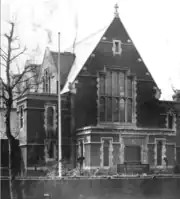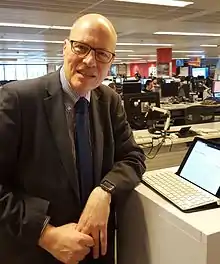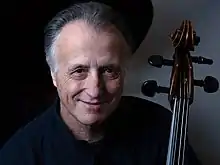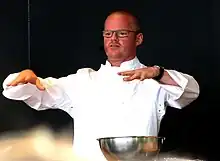Latymer Upper School
Latymer Upper School is a co-educational public school in Hammersmith, London, England, between King Street and the River Thames. It derives from a charity school founded in 1624 by the English merchant Edward Latymer, which has existed continually since. With approximately 1,200 pupils, most students are admitted to the Upper School through examination and interview at the age of eleven, with some also entering into the Sixth Form at 16. The school's academic results place it among the top schools nationally, and it has historically accepted under 10% of applicants.[lower-alpha 1]
| Latymer Upper School | |
|---|---|
 | |
| Address | |
, , W6 9LR United Kingdom | |
| Coordinates | 51.492°N 0.237°W |
| Information | |
| Type | Public school Independent day school |
| Motto | Latin: Paulatim ergo certe (Slowly Therefore Surely) |
| Religious affiliation(s) | Church of England |
| Established | 1624 |
| Founder | Edward Latymer |
| Sister school | Godolphin and Latymer School |
| Local authority | Hammersmith and Fulham |
| Department for Education URN | 100370 Tables |
| Head | Susan Wijeratna[1] |
| Staff | 180 full time, 37 music staff |
| Gender | Co-educational since 2004 (Formerly all-boys) |
| Age | 7 to 18 |
| Enrolment | 1,284 |
| Colour(s) | Black, blue and white |
| Publication | The Latymerian |
| Former pupils | Old Latymerians |
| Boat Club | Latymer Upper School Boat Club |
| Website | www |
Having moved to its present site in 1863, the school spent a period of time in the mid-20th century as a direct grant grammar school, before becoming independent with the system's abolition in the 1970s. Remaining single-sex until 1996, when Sixth Form admissions were opened to girls, the school transitioned to full co-education in the first decade of the 21st century.
Latymer has been consistently ranked among the leading schools in the country academically. Its list of alumni include diplomats, numerous former and current members of both Houses of Parliament, the winners of several Olympic medals, and many prominent figures in the arts and sciences.
History
Origins

Latymer Upper School was founded in 1624 by Edward Latymer, a wealthy lawyer and puritan, who left part of his wealth for the clothing and education of "eight poore boyes" from Hammersmith. For the next twenty years, local boys were educated in a school erected in Fulham's churchyard, moving in 1648 to another school built in Hammersmith. Later, in 1657, a parochial charity school was set up, which served as the Latymer legacy for the following century until it was rebuilt in 1755.
A new facility was built on what is now King Street in Hammersmith in 1863, and was replaced in 1890 with a new building between King Street and the Thames. This structure persists to the present day as the core of the Upper School. The site also includes Latymer Prep, a preparatory school, which takes pupils aged 7 to 11.
Recent history
In the 1950s, the school was a direct grant grammar school, which took large numbers of state school pupils, whose fees were paid by the local authority, solely on the basis of merit. At the same time, it continued to take some fee-paying pupils. The Direct Grant system was abolished from 1975, and the school became fully independent of government funding. The Sixth Form has been co-educational since 1996, and in 2004 the main school started to become co-educational, with the introduction of girls into Year 7. With that year's entry moving into Year 11, the school became fully co-educational by 2008. Each year, the school gathers in the nearby St. Paul's church for "Founder's Day", an annual reflection upon and celebration of Edward Latymer and other benefactors of the school. As a member of the HMC it is a public school.
Student body
Pupils come from a wide area of London. 176 pupils are on means-tested bursaries, 70 of whom are on 100 per cent bursaries. A school statement in the Good Schools Guide said: "We attract a real mix from city investors, media types and academics living in leafy streets through to families on the White City estate, which is surely better than just those from a privileged bubble mixing with each other".[2]
Finances
Tuition for 2020 was £21,000 per year, plus other mandatory and optional fees.[3]
Latymer offers a bursary programme, with 176 pupils on means-tested bursaries.[4][5] For families with incomes unable to pay the fees, Latymer Upper is free.[6] The school has a substantial fund from donations ring-fenced to fund bursaries.[7][8]
Academics
Latymer Upper School is one of the highest academically performing schools in the UK historically and to date.[9] The school's own on-site prep pupils enter the Upper School automatically at the end of Year 6, Tatler Schools Guide commentated that 'competition for Latymer places is hotter than ever: 1,100 applicants sat the exam last spring; 400 were interviewed for 168 places'.[9] The examined subjects are in English and Maths, which are followed by an interview. There were 33 Oxbridge places in 2017, and an increasing number went to US universities such as Brown, Columbia, Dartmouth, Harvard, Princeton, Stanford, Pennsylvania and Yale.[10]
Activities
There are over 140 clubs and societies at Latymer, including the J. S. Mill, Literary and Latymer Societies. There are also clubs for bridge, chess, debating, philosophy and photography. The Drama Society holds several productions each year.[11]
The school has links with other schools across Europe with a joint orchestra, as well as other trips (such as work experience), with Godolphin and Latymer School. There are trips abroad throughout the year, such as skiing trips, language exchanges, work experience in Paris, Berlin and Stockholm, Classics trips to Italy and Greece, sports tours and expeditions. Latymer Upper also participates in the Duke of Edinburgh Award scheme.[12]
Latymer contributes to local music, art, drama, dance and sports projects, as well as acting as venue for a Sunday School and Scuba diving for the disabled. Sixth Form students are encouraged to help in local primary schools and old people's homes as part of their general studies program, as well as with groups helping the homeless and disabled. In addition, the school offers all students a trip every year in 'Activities Week'. Destinations have included Spain, the Ardèche gorge in the south of France.[13]
Extracurricular
The PE department offer extracurricular programmes. Optional sports include rugby, cricket, rowing, athletics, football, tennis, cross-country, fencing, karate, scuba diving, table tennis, squash, badminton and swimming. Over 700 students are currently learning to play a musical instrument, with 175 involved in the school's two full orchestras and five string orchestras and around 150 in the choirs.
Rowing
The Latymer Upper School Boat Club has been open for over a century to school pupils, and offers rowing to both genders.[14] The boat house has taught three Olympic rowers, including Andy Holmes, Olympic gold medal rower (1984 Games and 1988 Games),[15][16] Henry Fieldman, Olympic bronze medal rower (2020 Games) and the Olympic Silver medallist Jim Clark was a coach. The Boat Club has gone on to win Henley Royal Regatta, most recently with the win of the Diamond Jubilee Challenge Cup.[17][18]
Facilities
Academic facilities

The Main Hall is the primary building around which the rest of the campus is grouped; it is used for assemblies. It is the original Victorian school building. The Design block at one end of the main hall houses the Design & Technology labs. The Modern languages block is a 1960s building housing the modern and classical languages departments. The Latymer Theatre and Arts Centre, opened in 2000, includes a 300-seat galleried box theatre, music practice rooms, art galleries and studios, plus a cafe and atrium area. The Latymer Performing Arts Centre, completed in 2009, contains drama studios, rehearsal rooms and a 150-seat recital hall.[19] The Science and Library building, opened in 2010, includes labs for the three sciences and a library with seating for more than 200 pupils which occupies a floor at the base. Van Heyningen and Haward Architects were responsible for the design and delivery of these four buildings during a ten-year working relationship with the school.[20]
Athletic facilities
- The Latymer Upper School boat club faces the Thames and spans four stories.
- The Sports Centre was opened in March 2016, which includes a six-lane swimming pool, basketball hoops, badminton markings, cricket nets, a fitness suite, and a rock climbing wall whilst at the same time offering an area for all pupils to take their examinations.[21]
- The school's playing fields are about a mile and a half away, on Wood Lane, with a £2m sports pavilion and changing rooms completed in 2004. The playing fields are used for training by the England Rugby Team[22]
- The Sports pavilion, costing £2m and containing changing rooms was opened in 2004.
Other facilities
- The chapel is housed at the top of the Geography & History building.
Coat of arms
The school for many years used the armorial bearings of the founder, Edward Latymer. This included his motto, paulatim ergo certe ("Slowly therefore surely"), which doubled as a pun, including the word "latimer" (spelt thus as there is no letter y in Latin). An intermediate coat of arms was taken from one of the quarters of the original coat of arms which combined that of the Latymer Foundation and of the Latymer School. In 2004, the motto was simplified, before being changed again to its current form in September 2020.[23] The original arms continue to be used, with a different motto, by the sister school, The Latymer School.
Public examination results
Latymer has been ranked consistently in the leading schools in the country academically based on the merit of its position in the national GCSE and A level examination performance tables combined with one of the highest Oxford and Cambridge acceptance rates of any secondary school or college.
GCSE & A-Level summaries over five years[24]
| GCSE summary[24] | A level summary | ||||||||||||||||||||||||||||||||||||||||||||||||
|---|---|---|---|---|---|---|---|---|---|---|---|---|---|---|---|---|---|---|---|---|---|---|---|---|---|---|---|---|---|---|---|---|---|---|---|---|---|---|---|---|---|---|---|---|---|---|---|---|---|
|
|
Old Latymerians
Politics
- John Beckett (1894-1964), dissident politician[25]
- Norman Blackwell, businessman and politician
- Peter Hendy, Chairman of Network Rail
- Alan Hunt, former British High Commissioner to Singapore
- John Killick, former British Ambassador to Moscow
- Ian Percival, former Solicitor General
- Joshua Rozenberg, legal affairs correspondent for the Daily Telegraph[26]
- Andy Slaughter, Labour MP for Hammersmith
- Keith Vaz, former Labour MP for Leicester East[27]
- Peter Walker, former Conservative Cabinet Minister
- Larry Whitty, former Labour Party General Secretary
- George Walden, former Conservative Party Education Minister
Film and theatre
- William Hinds (1887–1957), jeweller and one time owner of Hammer Productions film studios
- Jessie Cave, actress
- Lily Cole, actress and model[28]
- Hugh Grant, actor[28]
- Martyn Green, actor-singer, comedian
- Christopher Guard, actor
- Natalie Abrahami, theatre director[29]
- Ophelia Lovibond, actress
- Imogen Poots, actress
- Augustus Prew, actor
- Toby Regbo, actor[30]
- Alan Rickman, actor
- Mel Smith, actor, comedian, film director, producer, writer
- Sean Teale, actor
- Will Theakston, actor
- Alix Wilton Regan, actress
- Rufus Jones, actor
- Gordon McDougall, theatre director and academic
Music
- Dom & Roland, drum & bass DJ/producer
- Ralph Hill, music critic
- Ils, electronic music producer and DJ
- Walter Legge, record producer and classical impresario
- Jamie Quinn, known as Matrix
- Joshua Lloyd-Watson and Tom McFarland, core members of Jungle[31]
- Charlie Morgan, musician
- Matt Quinn, known as Optical, musician, producer, and DJ
- Arlo Parks, singer
- Jay Sean, singer
- Cliff Townshend, jazz musician, expelled from Latymer, father of Pete
- Raphael Wallfisch, cellist
Sport
- Andy Holmes, Olympic gold medal rower[32]
- Antony Hooper, cricketer[33]
- Simon Hughes, cricketer
- Hugh Jones, athlete
- Dan Luger, rugby player
- Dominic Waldouck, rugby player[34]
Other fields
- Richard Jackson, Bishop of Hereford
- Heston Blumenthal, TV chef and owner of The Fat Duck[35]
- Ajahn Brahm, Buddhist monk
- Ed Condry, Bishop of Ramsbury
- Thomas Haller Cooper, member of the Waffen SS's British Free Corps[36]
- Bill Emmott, former editor of The Economist
- Sir Andrew Haines – Director of the London School of Hygiene & Tropical Medicine
- Harold Spencer Jones, Astronomer Royal[37]
- Hilary Jones, GMTV in-house doctor
- Milton Jones, comedian
- Giles Milton, author and journalist
- Philip I. Murray, professor of Ophthalmology
- Tim Moore, travel writer
- John D. Ray, Egyptologist[38]
- Jerry Roberts, wartime codebreaker at Bletchley Park
- David Shoenberg, physicist, researcher into supercooling
- Eric Simms, natural history broadcaster
- Jim Smith, scientist[39]
- Nicholas Stern, ex-Chief Economist of the World Bank and author of the Stern Review on climate change
- Allegra Stratton, journalist[40]
- Deyan Sudjic, Director, Design Museum, London
- Zbigniew Szydlo, historian of chemistry
- Ibrahim Taguri, community worker
- David Tress, painter[41]
- Fred Vine, geologist and co-discoverer of plate tectonics[42]
- Adrian Weale, writer and historian
- Roger Westman, architect
- Gordon Brook-Shepherd, author[43]
Notable former staff
- Jim Clark, rowing coach
- Alastair Heathcote
- Peter Jacobs, piano
- Max Kenworthy, taught music
- Robert King (conductor), taught music[44]
- Shaun Sutton
- Jean Driant, taught French
See also
- 1620s in England
- Godolphin and Latymer School
- The Latymer School, situated in Edmonton, which was also covered by Latymer's bequest.
- Gelehrtenschule des Johanneums (twinned school)
Notes
- In 2016
References
- "New Head announced for Latymer Upper School". RS Academics. Retrieved 15 January 2023.
- "Latymer Upper School, London". Good Schools Guide. Archived from the original on 22 May 2010. Retrieved 31 August 2010.
- School Fees Information
- "The dilemma of a left-leaning private school teacher". Tes. Retrieved 27 April 2020.
- Connington, James (17 October 2015). "Can't afford private school fees? You may not have to pay". The Daily Telegraph. ISSN 0307-1235. Retrieved 27 April 2020.
- Viña, Gonzalo (28 April 2016). "Britain's private schools offer record bursaries". Financial Times. Retrieved 27 April 2020.
- Lough, Catherine (28 February 2020). "Revealed: Private schools with the highest surpluses". TES. Retrieved 1 April 2021.
- Bray, Paul (28 March 2013). "Private school bursaries: helping talent shine through". The Daily Telegraph. ISSN 0307-1235. Retrieved 27 April 2020.
- "Latymer Upper School". tatler.com. Retrieved 28 June 2016.
- "A-Level Results: Another record-breaking year!". www.latymer-upper.org. Archived from the original on 29 August 2012. Retrieved 13 January 2022.
- Clubs Archived 2008-07-08 at the Wayback Machine Latymer Upper School
- Clubs, Activities and Trips Archived 2009-01-31 at the Wayback Machine Latymer Upper School
- Activities Week Archived 2008-09-07 at the Wayback Machine Latymer Upper School
- "Inside the mind of a Team GB rowing cox ahead of Tokyo 2020 Olympic Games". South West Londoner. 10 March 2020. Retrieved 27 April 2020.
- Quarrell, Rachel (25 October 2010). "Death of double Olympic champion Andy Holmes sparks health alert for rowers". The Daily Telegraph. ISSN 0307-1235. Retrieved 27 April 2020.
- "Tributes to Olympic rower Holmes". BBC News. 21 November 2010. Retrieved 27 April 2020.
- "Henley Royal Regatta Day 4 - as it happened". www.henleystandard.co.uk. Retrieved 27 April 2020.
- Quarrell, Rachel (5 July 2019). "German eight on last warning after repeat offence at Henley Royal Regatta". The Telegraph. ISSN 0307-1235. Retrieved 27 April 2020.
- New Music Building Building, Latymer Upper School
- "van Heyningen & Haward: Latymer Upper School, West London". Architecture Today. Archived from the original on 16 August 2016. Retrieved 28 June 2016.
- "New Sports Centre opens - LUS".
- "The England rugby squad trains at the Kensington Latymer Upper School..." Getty Images. Retrieved 27 April 2020.
- Old Latymerian News, October 2004 Archived 2006-10-29 at the Wayback Machine (PDF document). Accessed 15 December 2006.
- "Latymer Upper School". Latymer-upper.org. Retrieved 17 February 2017.
- Francis Beckett The Rebel Who Lost His Cause – The Tragedy of John Beckett MP, London: Allison and Busby, 1999, pp. 15–16
- Rubinstein, William D.; Jolles, Michael A.; Rubinstein, Hilary L. (2011). "Rozenberg, Joshua Rufus". The Palgrave Dictionary of Anglo-Jewish History. Palgrave Macmillan. p. 832. ISBN 978-1-349-51951-4.
- "Keith Vaz: Who is the Labour MP caught up in male prostitute claims?". The Independent. 4 September 2016. Retrieved 25 June 2018.
- Griffiths, Sian. "Latymer Upper School forces out seven over drugs | News". The Sunday Times. Retrieved 25 June 2018.
- "Natalie Abrahami: In the right direction". Ink Pellet.
- "The trickle-down effect has dried up | News". Thisislondon.co.uk. 16 April 2009. Archived from the original on 7 December 2010. Retrieved 26 January 2012.
- "Everything You Need To Know About Britain's Hottest Band". esquire.co.uk. 1 July 2014. Archived from the original on 27 December 2015. Retrieved 28 June 2016.
- "Andy Holmes – Obituary". Daily Telegraph. 25 October 2010. Retrieved 18 January 2011.
- The Cambridge University List of Members. Cambridge University Press. 1991. p. 650.
- "Latymerian". September 2016.
- Tibbetts, Graham (24 October 2008). "Harry Potter Star Alan Rickman Funds School Bursary". The Daily Telegraph. London.
- Landwehr, Richard (2012). Britisches Freikorps: British Volunteers of the Waffen-SS 1943–1945 (3 ed.). Vermont: Merriam Press. p. 77. ISBN 978-1-3127-6244-2.
- Woolley, R. V. D. R. (1961). "Harold Spencer Jones, 1890–1960". Biographical Memoirs of Fellows of the Royal Society. 7: 136–145. Bibcode:1961JRASC..55..117S. doi:10.1098/rsbm.1961.0011. JSTOR 769402.
- "John David Ray". People of Today. Debrett's. Archived from the original on 24 September 2015. Retrieved 1 August 2014.
- Anon (2016). "Smith, Sir James Cuthbert". Who's Who (online Oxford University Press ed.). Oxford: A & C Black. doi:10.1093/ww/9780199540884.013.35379. (Subscription or UK public library membership required.)
- Stone, Jon (8 October 2020). "Who is Allegra Stratton, Boris Johnson's new spokesperson?". The Independent. Archived from the original on 8 October 2020. Retrieved 9 October 2020.
- Mitchell, Bernard (photographer). "David Tress Drawings". Welsh Arts Archive. Retrieved 15 October 2023.
- Profile at Bookrags.com
- "Gordon Brook-Shepherd". The Daily Telegraph. 30 January 2004.
- Latymer Upper School, Directories, 1983, 1984, 1985, 1986.


.jpg.webp)
.jpg.webp)



_Smith.jpg.webp)
.png.webp)